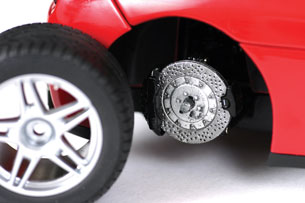Module 3—Effects of Force on Velocity

© Image Courtesy of Shutterstock.com
 Reflect and Connect
Reflect and Connect
The amount of friction between train wheels and the track is based on the normal force and the coefficient of friction between the dry steel of the wheel and the dry steel of the track.
The coefficient of friction for steel on dry steel is 0.41 (static) and 0.38 (kinetic).
The GE Evolution series locomotive has a mass of 188 000 kg. Determine the amount of static and kinetic friction force available to the wheels. Is this force equivalent to the maximum braking force, the maximum useful engine force, or both?
 Discuss
Discuss

© Kharidehal Abhirama Ashwin/shutterstock
The antilock brakes prevent car tires from locking up and skidding. Research how antilock braking systems work, and identify their strengths and weaknesses. When you go to the discussion area, be sure you can explain why a car can stop faster and safer if the tires do not skid.
D 1. Post an experience you or someone you know has had where antilock brakes were used.
D 2. Post an analysis of the strengths and weaknesses of the antilock braking system. Use diagrams where appropriate in your posting.
 Reflect on the Big Picture
Reflect on the Big Picture
Each of the Reflect on the Big Picture sections in this module will ask you to consider the movement of people or goods. To help you enhance your learning experiences for this lesson, complete at least one of the following activities:
- Take or find a series of photos of a corner with traffic lights or a stop sign that illustrate the forces acting on the vehicles and their passengers. Think up captions for the photos that would help you remember how the forces were working.
- In car-chase scenes of action movies, you often hear vehicles screeching around corners. In normal driving situations, you don’t want to treat your vehicle so poorly. Create a free-body diagram to help analyze the forces acting on a car skidding around a corner. Contrast this with a free-body diagram of an everyday turn.
Store your completed reflection in your Physics 20 course folder.
 Module 3: Lesson 3 Assignment
Module 3: Lesson 3 Assignment
Remember to submit the Module 3: Lesson 3 Assignment to your teacher.